The bones of deceased Guaraní shamans used to decorate forest pockets in pre-colonial times, when Mata Atlântica, “The Atlantic Forest,” still stretched out its arms across South America. From modern-day northeastern Argentina to the southern Brazilian coast, the “Atlantic Forest” provided the continent’s First Nations with a lush diversity of ecoregions to explore, to wander and live in. When seventeenth-century Jesuit missionaries found out about these spiritual temples, they persuaded the natives to lead the way to the holy grounds.
In the end, when Colonialism had established its new world order, and the Guaraní’s spiritual mobility limited, the shamans’ bones ended up six feet underground, in accordance with Christian custom. In early missionary chronicles, the Jesuit priest António Ruiz de Montoya retells the Guaraní’s testaments of the buried shaman’s cries into the night: “Let me out, I can’t breathe down here!”
A New World sprang forth from the earth, and a storm followed in its tracks.
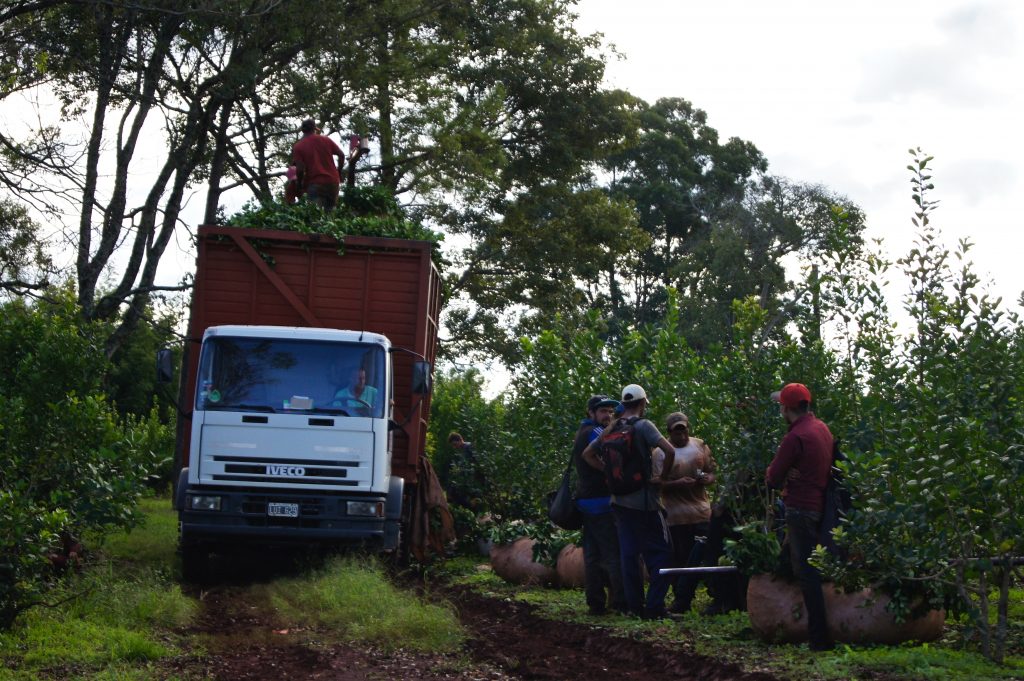
✵
Roque Pereira recalls the frosty morning when his father, for the first time, brought him along to work at the maté plantations. The father was a tarefero, a leaf picker – and from that day on, so was his son.
“I was eleven,” says Roque and opens the window in a damp and chill kitchen. He is at the headquarters of Asociación de Tareferos, or ADT, in central Oberá, Argentina. He lets in Saturday’s heavy rain, and another heartfelt memory from the decades on the plantations. “Weekends equals bad luck for tareferos. No work, and no money. Nada.”
He then empties the maté gourd, and watches while the shredded leaves fall into the garden soil. A circle is closed. Once claimed from the earth, now re-grounded.
Roque leaves the window ajar while he lights the gas stove and collects his thermos from a cupboard, under a damp portrait of Evita Perón. He first pours cold water into the thermos before he fills the kettle. In the maté consumer’s private world it’s about ceremonies, but in the plantation fields and industrial practice it’s all about roots. About cultural, political and social links that intertwine workers and producers, man and nature, poverty and wealth. Remove one piece, and the center cannot hold.
“It’s all about paving way for a better tomorrow for our children, the next generation,” says Roque. “But we can’t do it alone, we need new structures.”
As a Guaraní, and member of Argentina’s indigenous and most poverty-stricken minority, justice has never seemed more than a word. A distant dream. The reality for the taraferosis a life marred by cuts from branches and a body bent from mile after mile of carrying sacks of maté leaves. A life in the shade of development, an existence at the political and economic bottom.
“But without my efforts, without the cuts in my hands and the sweat on my forehead – no maté,” he says.
✵
[T]areferos get paid by the pound, and delivery of maté leaves equals survival. Every sack weighs 200 lbs., which the tareferocarries on his back through thick vegetation to a waiting truck. The truck is waiting to leave for a mill owned by one of the industry’s big guns. The arrival at the mill signals the end of the tarefero’s contribution; at the mill the leaves and branches are exposed to heat, dropped on liquid, and dried. The maté is then aged for nine months prior to departure for store shelves. Online, one can purchase a pound of processed maté leaves for a handful of dollars. The tareferoearns 80 centavos per kilo, or $0.01, leaving him with a daily salary of two dollars – assuming the tareferoprovides the truck with two full sacks.
The ADT union was officially founded in 2011, although tareferos started to organize themselves back in 2002. The Argentine neoliberal economic experiment had ruined a whole country and cast thousands, if not millions, of people into hunger and despair. Misiones’s maté industry was severely weakened, and companies had to adjust to a new reality while famine struck the Guaraní people. Tareferos, whose families relied on their meager incomes, were left without a livelihood.
In 2011, then-President Cristina Fernández de Kirchner had Law 26.727passed through the senate, securing basic labor rights for around one million rural workers, many involved in matéproduction. These rights included minimum wages, paternal leave for 30 days, and maximum eight working-hours per day.
“It got better for a while,” says Roque Pereira. “But many of the promises of inspections and collecting information about the workers, to provide them with paper and legality, were never kept.”
And now, with the return of the IMF-regulated policy, under the presidency of Mauricio Macri, few tareferosdiscern light at the end of the economically troubled tunnel. The provinces paid a high price for the neoliberal government’s Russian roulette game with the country’s currency. The Argentine peso was tied to the US dollar, and the IMF imposed an austerity package. That package meant loosened labor rights, further privatization, and less budget means for welfare sectors. And in a province like Misiones, maté workers paid the ultimate price for a national debt that never contributed to livelihoods. A whole country was taken hostage by international monetary institutions and private banks, and then – when Macri again in 2018 turned to IMF for a $60 billion loan – history repeated itself.
“Once again, we – and then I refer to the working class of Argentina, and in particular workers in heavy industries such as the maté production – had to pay the price for this neoliberal dream that everything improves, only if you liberate it all and cast it to the market. Well, twice since the turn of this century, facts have proven the economics wrong.”
ADT struggle to make the interests of the tareferos heard from a position at the rock bottom of a multi-billion-dollar industry. Public outcry in protest of skyrocketed matéprices occasionally make national headlines – tarefero’s demands for better wages and improved working conditions, however, seldom make headway in the local press.
The kettle on the stove beeps and steams. Roque Pereira pours fresh leaves into the gourd and sips using a bombilla, an iron straw. The bitter smell of matéfills the kitchen while he sinks into memories. After a few sips, he looks up on the wall where a drawing – a gift from his daughter – shows a tareferowith bent back, carrying a sack of leaves. The burden is visible in the eyes of the image, the same glance Roque Pereira’s own children used to find in their family’s sole provider.
“For me, it started like it normally does in this occupation,” he explains. “After decades of cutting, carrying and dragging, you start to notice the downfall of knees and back. This is the moment when my own father, along with many other parents before and nowadays, decided that he couldn’t provide for his family alone. He needed help, and introduced me to the work. Many people have no choice, the poverty in Argentina keeps many children away from school.”
Three children died in 2013 when a truck carrying tareferos and harvested leaves overturned on its way to a mill not far from Oberá. It was not the first time that children died in matécountry, but the tragic incident awoke a national outcry. There were demands for stricter regulations and controls to crack down on modern slavery and child labor.
“Look,” laments Roque, “We’ve heard a lot of sweet and concerned voices about the welfare of tareferosthroughout the years. But in the end, it’s never been more action than words.”
For Roque Pereira, who underlines his luck at no longer working out in the fields, but at the ADT Oberá headquarters, every fatal accident involving a child is a remembrance of the industry’s historically bloody roots.
“In my family, child labor ends with me,” says Roque Pereira. “My children are going to school, they educate themselves, and will never work as tareferos. Education is the magic spell that’ll break my family curse.”
✵
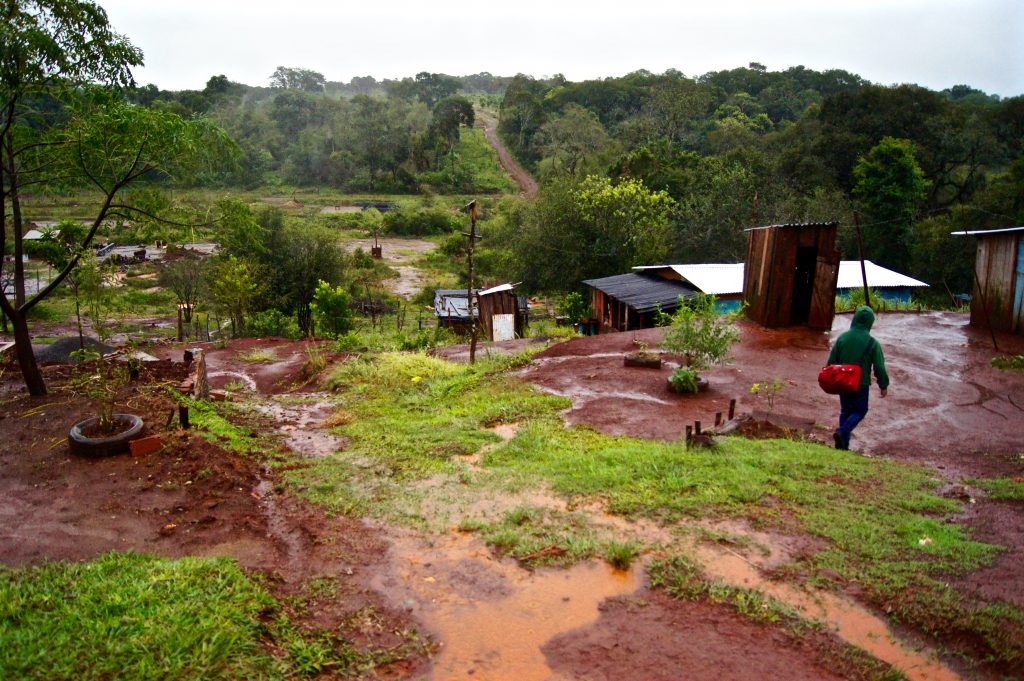
[T]areferos and ADT union activists get together for a Saturday barbeque, offering pastries and soda, while the rain pounds the tin roof. There is also reviros, a typical tarefero dish made of flour and fat. The dish’s origin is said to spring out of poverty; legend has it that a mother was grieving the fact that she didn’t have the means to provide for her children. As she wept over a pot of flour, her tears provided enough moisture to make a dough out of the flour.
Daniel Rodriguéz recalls thereviro plate he had on the morning October 2, 2000, in Colonia Aurora, along the Brazilian border. It was his last meal before everything went to hell. After the meal, Daniel filled his second sack with matéleaves for the day and set off for the awaiting truck at the end of the clearing.
]“But there, waiting, was another truck,” he remembers. “Not the one we usually drove to the mill with. This one was a real piece of shit. But what could we do? We just loaded the fucker and hopped on top of it. It’s not the tarefero’s job to ask questions.”
Off they went, and down the roadside.
Daniel retells the ordeal with vivid details and a self-empathy learned after many years of recurring nightmares. His body was broken, and the accident was followed by five years of rehabilitation – and unemployment. He couldn’t walk for a long time, and his fear of riding trucks convinced him to seek assistance from the provincial authorities.
“I was treated as if I were a criminal,” he says. “The maté company wouldn’t help me, as far as they’re concerned, there were no papers linking me to them. And in the eyes of the authorities, during a national economic crisis, I was a todo negro, someone who’s not entitled to unemployment assistance, so there was no chance in hell for me to get counseling, compensation, nada. Me and my family were hung out to dry.”
He can understand why his then-girlfriend broke up with him, and took their child with her into another relationship. One where there were better possibilities for putting food on the table.
“She didn’t think I would be able to walk again, or work,” he says. “I was left to recuperate alone. And once I was physically healed, to keep on working as a tarafero was the only option I had. I just pray for my child to stay at school.”
Broken bones may heal, but the scars after a broken life remain. As a child, he dreamt of a career as a soccer player. Now, as a man in his mid-40s, Daniel has limited mobility due to his accident. As he looks back, he reflects that things couldn’t have happened in any other way; the life of a tarefero is bound to social and economic structures, rooted in the region’s historical DNA.
“I was 26 years old at the time of the accident,” he says, “Now, I fear every truck transport. I have no choice, if I don’t go, I won’t get paid – but it’s a fear that never leaves my body.”
✵
Out there, in the woods and remnants of a once staggering wilderness, are whole families living in shelters of tarpaulins and cardboard – a parallel society whose inhabitants enjoy no access to healthcare, education, or proper housing.
“They live their lives as modern slaves,” says Roque Pereira. Tareferocamps, where minors and small children live out in the wild under horrific conditions, reach the local press in the wake of dismantling raids. “But these people’s fates, and why they are forced to live out there in the first place, seldom reach the public’s eye. And these findings are only the tip of an iceberg. There are many people out there.”
There are no reliable numbers, but it’s estimated that tareferosand their families number 75,000 people in Misiones alone. Roque credits the lack of reliable numbers to political and economic interests that depend on the status quo.
“The whole industry is dependent on poor people to take on the most dangerous and least paid jobs,” he says.
One new settlement of maté workers has popped up in the outskirts of Oberá, in a valley next to a middle-class suburb. This working-class barrio, called Sapucay,is made up of shacks built with damaged wood and tin. There is limited access to running water, and the only electricity is produced by generators or stolen from nearby power lines.Dogs keep watch in sliding mud. Basic needs are ignored by authorities; fatal flooding has occurred, children are living without proper necessities, and many teenagers have already fallen into addiction.
The barrio is emptied during the day; most families are taking day jobs on maté plantations. A resident of the middle-class suburb next door, whose brick house sits behind a security fence, regards the inhabitants of Sapucayas “friendly ghosts,” like creations of a parallel reality.
“These people live completely beside the rest of society,” says Patricia Ocampo, co-founder of Un Sueño para Misiones (“A Dream for Misiones”), an organization that tackles child labor within the maté industry. “Misiones’s indigenous people are forced to take the least paid and most dangerous jobs.”
She points down the valley, but might as well refer to all of Misiones: “Now, they occupy land that used to be their ancestors’ home.”
✵
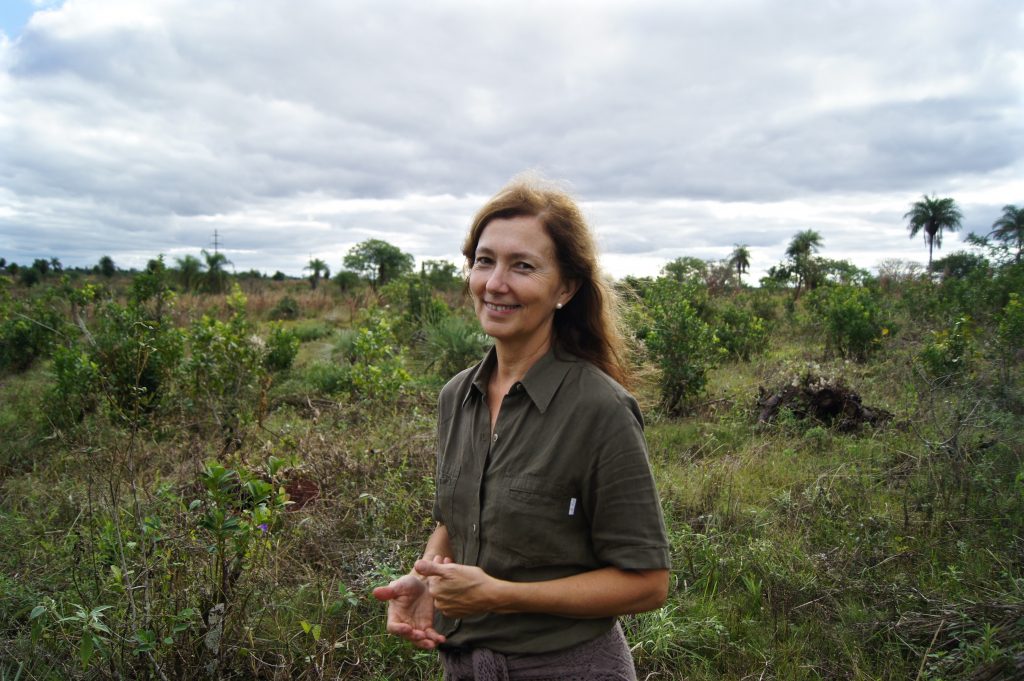
On a road that cuts through the Núñez family’s outstretched, century-old maté plantation, a lonesome ant carries the remains of a leaf. Now and then the ant stops, as if catching its breath, before amending the burden and then continuing its trek to the other side of the road.
Ana María Núñez, the current farmer and steward of the Santa Inés plantation, knows this place by memory and love. She has wandered here her whole life, upon Misiones’s mineral-rich red soil, and she never gets tired of the land. She loves the interplay between nature and its inhabitants, and the untouched jungle pockets surrounding matéplantations.
“Jungle was all you found here until the first decades of the twentieth century,” Ana María explains. “Back then, in the early days, there were no roads or means of transportation, so all the harvest had to be dragged and carried through the jungle, and down to the river.”
The river, Paraná, is still there, separating Argentina and Paraguay. The plantation still holds a sense of ecological purity and social isolation, despite the proximity to the city of Posadas. At dawn the world springs to life with the roars of brown howler monkeys, rather than traffic from Road 105.
“I’m glad that neither my grandfather nor the generation of my parents cut down this land,” she says. “All has been allowed to live on, thus making a walk here like a stroll back in time.”
The sense of timelessness is embodied not only in Santa Inés’s architecture, but in the sense that this is still a frontier; geographically isolated and far away from national capitals, and economically dependent on the earth.
Four centuries have passed since the first Jesuit missionaries set up camps, known as “Reductions,” to convert the semi-nomadic Guaraní tribes. For much of that time, the Atlantic Forest remained a hostile and impenetrable environment. But from the turn of the twentieth century, things have changed rapidly.
“People came here in search of maté trees,” says Ana María. “To them, maté was the path leading to a better life. It was their green gold.”
Organizing maté production in Misiones, however, turned out to be a difficult task. Maté trees grow wild and free all over Misiones, as well as in southern Brazil, Paraguay, and even in some parts of Uruguay. Still, farmers found it difficult to grow matéon fields, outside the jungle. Although missionaries learned the secrets of cultivating the plant in the countryside from their newly converted Guaraní brothers and sisters, it was a secret they never passed on. Then, in the early 1900s, a band of immigrant adventurers and entrepreneurs spent large sums of money and time to tame the herb that thousands, if not millions, of people – from Buenos Aires’s upper-class to the workers in Chilean copper mines – consumed daily.
“One of them was my grandfather,” says Ana María.
Pedro Núñez migrated from Spain to Buenos Aires in the 1870s before settling down in Posadas, then the gateway to Misiones’s maté bonanza. In 1901, Pedro Núñez became the first tourist entrepreneur to organize a river voyage to the mighty waterfalls of Iguazú, shortly prior his purchase of the piece of land that was named after his mother – Inés. Like many others, explains his granddaughter Ana María, he took a gamble and desperately tried to accustom the maté seeds to the red soil.
“But they couldn’t pull it off, and no one understood what they did wrong; they had the seeds, the climate, and the tools to make it happen – but the trees just wouldn’t grow.”
It wasn’t until the maté farmers let the seeds pass through the digestive system of birds that they started to grow, and when the trees began to pop up, forest made way for plantations. The plantations then paved way for an industry whose importance to the producing countries’ economy – and national identity – cannot be underestimated.
“To me, as a maté farmer, above all, it’s a way of life,” says Ana María.
She leads the way through hidden jungle pockets and fields. She halts, points at changes in the soil, or embraces trunks and whispers to them. In the background, the noise of tractors and chainsaws shred the silence. Days of harvesting are busy and noisy. For the Núñez family, the autumn harvest marks the end of a waiting game with Mother Nature.
“It takes time and patience to have maté trees grow without use of chemicals and pesticides,” she says. “If you choose to cultivate maté in a sustainable way, one must look after the soil and let nature do her job. Now, we can enjoy the harvest and make way for the beginning of the next crop cycle.”
✵
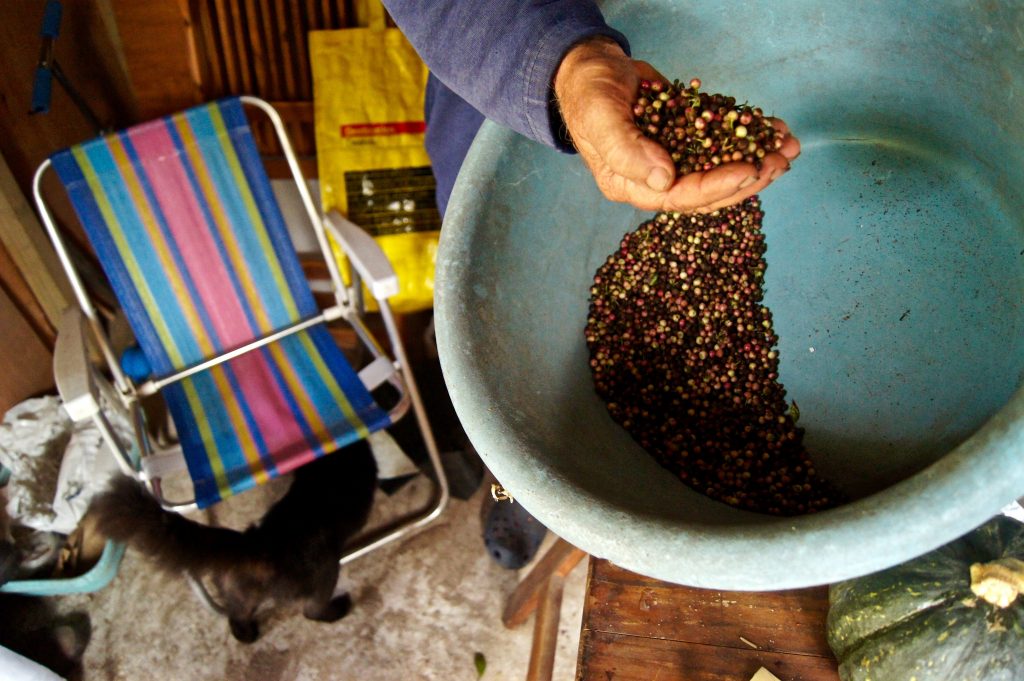
A single lamp dangles from the high ceiling in the plantation house’s saloon, and smears light on the mansion’s deep-brown walls. The night is quiet, and two Núñez siblings are having dinner. The farmer and the family accountant discuss work. The Núñez family can boast an annual maté production of 30 tonnes, but that is a modest yearly harvest in comparison to the industry’s big guns. The number one producer, Las Marías, produce 65,000 tonnes every year.
But it must never be a question of quantity, Ricardo Núñez explains as he takes a sip of his red wine. “We see over-production, and therefore the main question is how much matéthe industry can bear. How we – and whom – will consume yerba maté in the future, remains to be seen.”
In the 1990s, the industry was plagued by crisis and scandals. Pests were wreaking havoc on plantation trunks and farmers introduced pesticides on a large scale. This has upset a balance with nature and put the industry at a crossroads.
“It’s about choices now,” says Ricardo. “You either add pesticides and squeeze out the maximum of each harvest at the expense of the soil’s well-being, or you dare to be patient and let the trees live their own lives in harmony with the soil, without manipulating the production with toxic additives. Sure, you produce less and you better be prepared for long periods of time waiting to be able to harvest again, but you can await a tomorrow with a sustainable production.”
Most small-scale producers in Misiones, he says, choose to be patient.
✵
In the forests of Treinta y Tres, a sparsely populated department in rural eastern Uruguay, one hears whispers of ecological treasures, lost during the colonial era, being found in the wild again.
One of those treasures is free-growingyerba maté.
It may also be the case that these treasures were never truly lost because they had never been found. No one had ever explored the wilderness, not really. Not like Alberto Demicheli, founder and administrator of Caa Porá plantation in Quebrada Valley, and grandson of Alberto Demicheli Sr., Uruguay’s de factoPresident for a short stint in 1976. Back then, Uruguay was a military dictatorship ruled by the Colorado Party, and President Demicheli was shortly ousted due to his “liberal leanings.”
“Mind your step, it’s easy to forget that this is a forest.”
For someone whose name always will be linked to a sad and brutal past, the forests and wilderness of the Quebrada Valley have always been Alberto’s sanctuary. He is the sole person, other than the Forest Department, to have access to a large portion of this wilderness. At the brink of dusk, after a long day’s drive from the country’s capital of Montevideo, followed by another hour along steep gravel roads, at times no more than scars in the ground, Albert arrives home.
He parks in front of his hut at the heart of the family land, and kills the engine. He gets out of the car and breathes the fresh air. His shirt is stained by dust and gravel. Now, with little over an hour of daylight left, he’s determined to make the most of it. He normally spends most of his time sailing from different ports across the vast emptiness of the Atlantic Ocean, but it is here in the Uruguayan wild forests that his heart truly lies. It’s here where his life’s project takes place.
And it’s also where his steps lead him – into the forest.
It all started in 2002, the year when Alberto Demicheli became apioneer in a country whose maté consumption per capita is the highest in the world – but without its own production, and thus dependent on neighboring countries, mainly Brazil.
“Why doesn’t Uruguay, the country that consumes the most maté in the world per capita, produce its own? Ninety percent is imported from Brazil, the rest from Argentina.”
It simply isn’t doable, has been the recurring chorus. This song has been sung not only from the country’s influential agriculture and cattle industry, but from Uruguayan politicians – among them ex-President José “Pepe” Mujica. Which is why the Uruguayan maté’s unsung pioneer turned out to be a sailor who picked up on a rumor he heard back in the 1990s.
“I heard about matétrees growing wild around in Uruguay, and became curious,” says Alberto. “So, I started to do a little travel around, investigating the matter.”
Fifteen years and numerous days of travel along the Uruguayan countryside later, 1,450 trees of yerba maténow grow in Quebrada Valley’s vast and leafy forests. These trees grow from seeds Alberto planted in suitable forest spots. He emphasizes that wild-growing maté trees have been here for decades, perhaps even for centuries, without public knowledge. They’ve been left alone in the soil to stretch out and reach for the sky above the thick shrubbery.
“But remember,” he says, “this is not a maté plantation, nor is it a project funded by any commercial or scientific interests.”
It is a mere walk in the forest, listening to a sailor’s story.
“Most Uruguayan believe, and are led to think, that we neither have the climate nor the capacity to pull off our own maté production. That’s what we’ve been told for a long time, since loggers and the timber industry nearly destroyed Uruguay’s natural fauna. But, as you can see, there are still traces of untouched landscape left, and I’ve talked to people all over Uruguay who’ve either seen wild growing maté trees, or have managed to plant some in their own backyards. So, you might say that I just want to prove that it’s possible to cultivate maté, plain and simple.”
The maté trees thrive in “La Quebrada,” but it is still to be seen whether it would be possible to sustain nationwide production sufficient to serve Uruguay’s two million consumers. Eucalyptus for pulp takes up much of the suitable land, but with unfortunate effects on the environment and groundwater aquifers. There is also the question whether domestic investment in a large-scale maté industry would endanger the nation’s relationship with Brazil, whose southern states’ economies are tied up with the “Paraguayan tea,” the name Spanish Conquistadores long ago gave the beverage.
Maté began its extraordinary journey as a local sacred beverage, served only by semi-nomadic Guaraní tribes who held closely the mysteries of cultivating the seeds. It became a tool in the Spanish and Portuguese colonization of South America, leading to its modern-day status as an economic cornerstone of the economies of Argentina, Brazil, and Paraguay. Its potential as an instrument of political pressure has not been forgotten.
The matétree’s ability to grow in “La Quebrada” has seen many visitors to the forest throughout the years, and many more are expected to come. Argentine scientists, Brazilian investors, and small-scale Uruguayan maté farmers are all bewildered by Alberto’s achievement.
The mystery of the forest, of Caa Porá, embodies the mystery of yerba matéitself. A man with a machete wandering through a forest puts all life on high alert.
“And that’s the way it should be,” says Alberto, and stops by a two-headed, thick tree trunk. He smiles and recalls what happened here – “right here” – a few years ago.
As now, it was dusk.
“I was dead-tired after an entire day out in the forest, harvesting matéleaves and clearing up passages. I sat down for a smoke and some air, I was on my way back up to the house, and leant my back against this beautiful trunk – and fell asleep. I woke up when a wild boar tried to remove my shoe, intending to feast on my foot. I literally jumped up screaming, and took refuge in this verytree – and the boar ran away, frightened by my sudden moves.”
Alberto pauses and looks to his left, where a passage has sprung up in the shape of a natural tunnel.
“This is the core of La Quebrada,” he says. “Any human being that comes here has to realize that he or she is just one of many living things.”
✵
Darkness has swept its blanket over the forest when Alberto opens the door to his hut. He pours water into a kettle and fills the stove with wooden stickers. He then collects a bag of four-year old maté; picked, heated, dried, and stored in his hut built and inspired by Guaraní custom. Its tipi architecture welcomes the coming of the night, and the living beings that springs to life with it.
Alberto organizes a circle and passes the gourd and bombilla around. The Guaraní custom is to use the maté circle as a gateway to talks and company. In the morning, one can share dreams; in the evening, after dark, the events of the day. The silence settles, the sounds and echoes of the world outside of the hut form shapes of organic symphonies. Vapor from the maté gourd sails through the damp indoor air. A scent of burning wood and watered yerba maté.
The aroma of life.
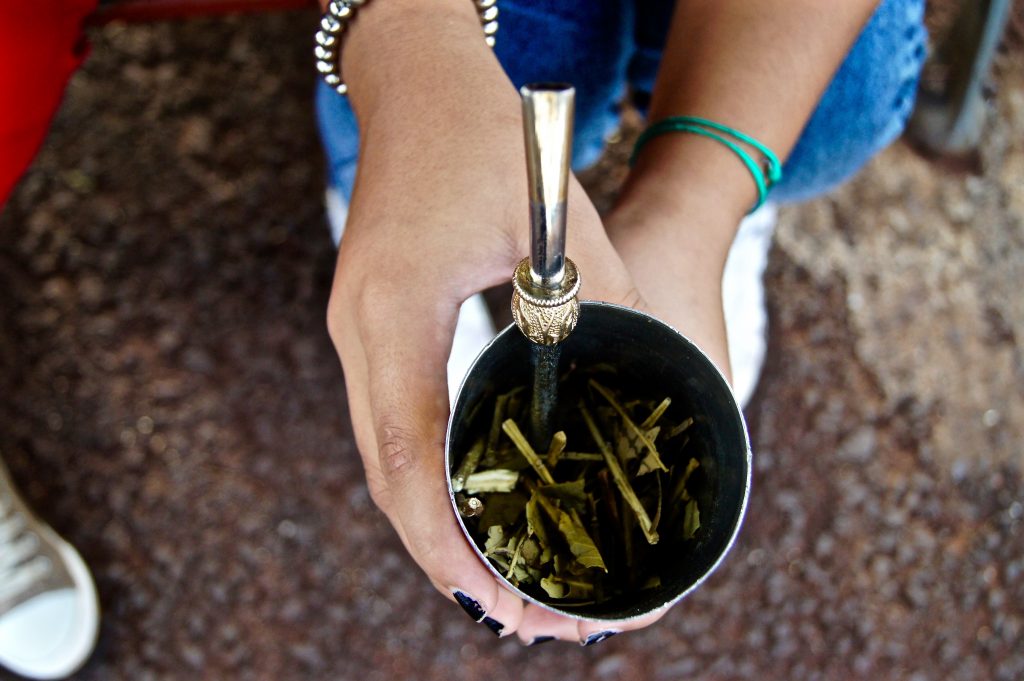
© Klas Lundström 2019
